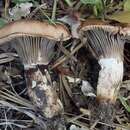en
names in breadcrumbs


The original description from Singer 1946:
“Pileo dilute purpurascente-vinaceo vel pallide griseolo-vinaceo; lamellis grisascentifbus; sporis 15-19.5 × 5.5-6.5 µ; cystidiis actione formaldehydi in sectionibus KOH imbutis in speciminibus recenter exsiccatis pulchre purpurascentifbus; stipite 50-80 × 8-12 mm., albo, hyalino-glutinoso et cothurnato; carne alba, laesa aeris actione rosascente ut minimum in base stipitis, FeSO4 ope atrata. Sub Pinis contortis et Pseudotsugis taxifoliis. Oregon Americae Borealis.”
Also Joe Cohen (user 4468) created this summary from various field guides:
1. Arora, Mushrooms Demystified (2d ed. 1986), p. 482 (Gomphidius key entry 3):
“Stalk with little or no yellow at base; fruiting body medium-sized to fairly small”
Id. p. 483, Comment on G. subroseus:
“_G. smithii_ can also be rather small, but shows little or no yellow in the base of the stalk and has a grayish to vinaceous-gray or brownish cap.”
2. Scates & Gibson, Field key to GOMPHIDIACEAE in the Pacific Northwest (1980, 2007)
“_Gomphidius smithii_ is another rather common species that will key out here. The size is like G. subroseus but there is less red in the cap and less yellow in the stem. It is also less pigmented in the cap and less yellow in the stem than G. glutinosus.”
3. Trudell & Ammirati, Mushrooms of the Pacific Northwest (2009)
“The rarely reported G. smithii has a grayish red cap, pinkish flesh in the lower stipe, and the stipe blackens when handled.”)
So looks to me like (1) size, (2) lack of yellow in stem base, and (3) cap color are consistent with all sources. I don’t see black bruising in the stem, but perhaps Dick Bishop (Leciman), who collected and IDed these was careful not to handle the stem, or any bruising faded by the time I took the photo.)
Dick Bishop (Leciman) adds:
As for choosing the ID it was a matter of it fitting better than other possibilities. Miller feels G. smithii is the same as G. glutinosus but G. smithii is generally regarded as smaller and less yellow in the base. I should also mention that Miller stated G. smithii occurs in California.
Gomphidius smithii is an edible mushroom in the family Gomphidiaceae that is found in the Pacific Northwest in North America.[2][3]
Gomphidius smithii is an edible mushroom in the family Gomphidiaceae that is found in the Pacific Northwest in North America.